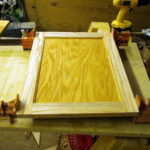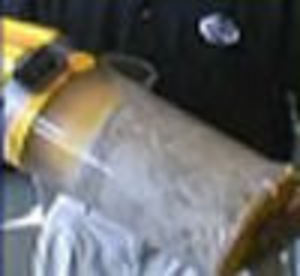Wood graining is a faux finish paint technique that mimics the look of real wood. This faux finish technique can be used to fix up an old table or chair, add dimension to interior or exterior doors, give storage chests and toy boxes an authentic wood appearance, refinish cabinetry,give your walls a warm rustic look, and much more! Wood graining is not very difficult to learn and doesn’t take many supplies to complete.
Supplies need for the wood graining paint technique:
– Wood stain (color of your choice)
– Clear polyurethane
– Graining tool
– Lint-free rags
– Paint brush
– Protective gloves
– Mineral spirits
Note – If you are unsure as to what any of the supplies above are, consult the paint professionals at your local home improvement store. They will direct you to the proper supplies.
Wood graining faux finish technique:
STEP 1 – Before you begin wood graining, it’s essential that the surface be clean and free of dirt, dust and debris. Go ahead and clean it with mineral spirits, using a clean, dry cloth to apply.
For safety reasons, wear protective gloves during anytime you work with wood stain or polyurethane! It’s also best to work in a well-ventilated area.
STEP 2 – Apply a thin coat of wood stain to a small area of the surface you are wood graining. It’s best to work in small sections (10″ – 12″) at a time to ensure proper coating. NOTE – If you are wood graining a door or paneled surface, begin faux painting the panels first. Once the panels are completely covered, you may then begin covering the remaining surface.
STEP 3 – Run the graining tool along the wet stain, using a rocking motion to form the wood grain pattern. There will be some nooks and crannies that the graining tool will not fit. These areas will require a dry paintbrush. Use short light strokes with the paintbrush to simulate the wood grain.
STEP 4 – Once the surface is completed covered with the wood grain effect, allow it to dry completely. For best results, allow it to set overnight. NOTE – What you will notice at this point is that the surface where the wood graining has been applied looks white. This is normal! In the next step we will be giving it a beautiful rich color.
STEP 5 – Using a lint-free rag, apply more of the wood stain to the surface. Again, work in small. 10″ – 12″ sections. If you’re wood graining a paneled surface, cover the panels first. This step will require a light coat of wood stain, which will give it the brilliant color of real wood. If the finish looks too light, apply a bit more wood stain until you get the look you like.
STEP 6 – Once the surface is covered, use a dry paintbrush to feather out any globs of stain that have gathered in the nooks and crannies. Allow to dry overnight.
STEP 7 – A protective coating of polyurethane will now need to be applied. Use a paintbrush to coat the surface evenly. This will protect the stain from chipping or flaking, and will give the surface a polished look.
More from Jennifer Wagner:
A Simple Guide to Sponge Painting
Suede Paint Technique
How to Lime Wash Walls
SOURCE:
Personal knowledge and experience
http://www.associatedcontent.com/article/2034195/a_simple_guide_to_sponge_painting.html?cat=6
http://www.associatedcontent.com/article/7908529/dress_up_your_home_with_faux_painting.html?cat=30
http://www.associatedcontent.com/article/2034177/suede_paint_technique_.html?cat=6
http://www.associatedcontent.com/article/2808290/how_to_lime_wash_walls.html?cat=6
http://yourwisdom.yahoo.com/your-home/5-ways-add-rustic-charm-home-article-acid.html






